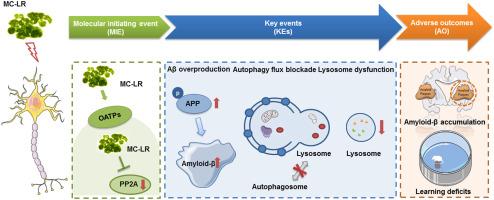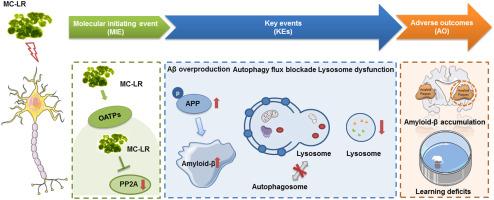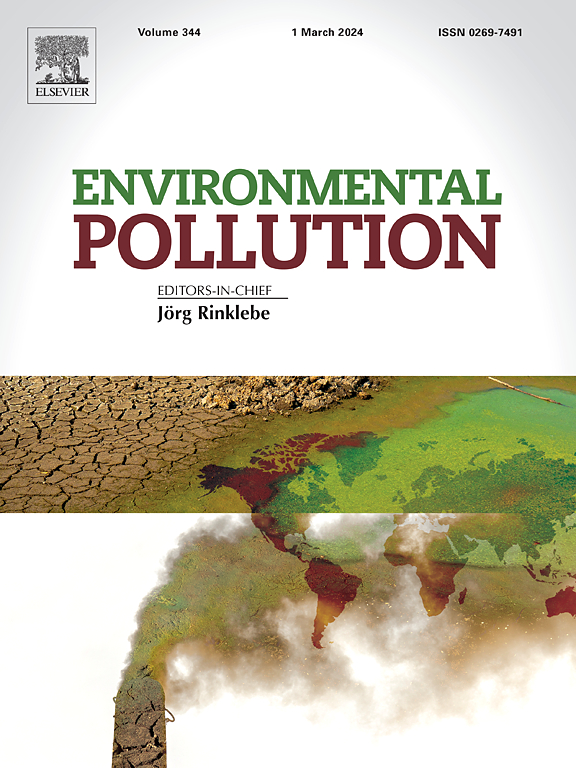暴露于 MC-LR 后,自噬通量受阻导致阿尔茨海默病样变化的不良后果途径
IF 7.6
2区 环境科学与生态学
Q1 ENVIRONMENTAL SCIENCES
引用次数: 0
摘要
微囊藻毒素(MCs)污染是一个关系到人类健康的世界性环境问题。微囊藻毒素-亮氨酸-精氨酸(MC-LR)是蓝藻产生的最常见的一种 MCs,可进入大脑并对神经系统造成损害。迄今为止,MC-LR 诱导神经毒性的机制尚不清楚。淀粉样蛋白-β(Aβ)沉积是阿尔茨海默病(AD)的标志。本研究揭示了环境相关剂量(1、7.5、15 μg/L)的MC-LR暴露可促进Aβ在小鼠大脑中的积累。从机制上看,我们首先发现Aβ积累与MC-LR暴露后神经元自噬通路阻断和溶酶体功能障碍导致的Aβ降解异常密切相关。此外,本研究还建立了一个以MC-LR神经毒性为导向的不良后果通路(AOP)框架。MC-LR抑制了神经元中蛋白磷酸酶2A(PP2A)的活性,这被认为是一个分子启动事件(MIE)。此外,暴露于 MC-LR 后还观察到自噬异常。自噬体-溶酶体融合受阻和溶酶体功能紊乱是暴露于MC-LR后的关键事件(KEs),它们导致蛋白稳态失调,最终导致Aβ异常降解和学习障碍,成为神经毒性的不良后果(AO)。该研究提供了有关MC-LR神经毒性的新信息,为了解环境化学物质诱导的神经退行性疾病的机制提供了新见解,对公众健康具有深远影响。本文章由计算机程序翻译,如有差异,请以英文原文为准。


Adverse outcome pathway of Alzheimer's disease-like changes resulting from autophagy flux blockade after MC-LR exposure
Microcystins (MCs) pollution is a worldwide environmental issue concerning about human health. Microcystin-leucine-arginine (MC-LR), the most common type of MCs produced by cyanobacteria, could enter the brain and bring about damage to the nervous system. Up to date, it is not clear about the mechanism of MC-LR-induced neurotoxicity. Amyloid-β (Aβ) deposits are hallmark of Alzheimer's disease (AD). In this study, we revealed that MC-LR exposure at environment-related doses (1, 7.5, 15 μg/L) could promote Aβ accumulation in mouse brain. Mechanically, we firstly found that Aβ accumulation is closely associated with abnormal Aβ degradation due to autophagy flux blockade and lysosome dysfunctions in neurons after MC-LR exposure. Moreover, an adverse outcome pathway (AOP) framework oriented to neurotoxicity of MC-LR was conducted in this study. MC-LR inhibited the activity of protein phosphatase 2A (PP2A) in neurons, which is regarded as a molecular initiating event (MIE). In addition, the abnormalities in autophagy were observed after MC-LR exposure. The hindered autophagosome-lysosome fusion and disrupted lysosomal function were key events (KEs) after MC-LR exposure, which contributed to proteostasis dysregulation, ultimately leading to Aβ abnormal degradation and learning deficits as adverse outcomes (AO) of neurotoxicity. This study provided novel information about MC-LR neurotoxicity and new insights into understanding the mechanisms underlying the environmental chemicals-induced neurodegeneration diseases, which has deep implications for public health.
求助全文
通过发布文献求助,成功后即可免费获取论文全文。
去求助
来源期刊

Environmental Pollution
环境科学-环境科学
CiteScore
16.00
自引率
6.70%
发文量
2082
审稿时长
2.9 months
期刊介绍:
Environmental Pollution is an international peer-reviewed journal that publishes high-quality research papers and review articles covering all aspects of environmental pollution and its impacts on ecosystems and human health.
Subject areas include, but are not limited to:
• Sources and occurrences of pollutants that are clearly defined and measured in environmental compartments, food and food-related items, and human bodies;
• Interlinks between contaminant exposure and biological, ecological, and human health effects, including those of climate change;
• Contaminants of emerging concerns (including but not limited to antibiotic resistant microorganisms or genes, microplastics/nanoplastics, electronic wastes, light, and noise) and/or their biological, ecological, or human health effects;
• Laboratory and field studies on the remediation/mitigation of environmental pollution via new techniques and with clear links to biological, ecological, or human health effects;
• Modeling of pollution processes, patterns, or trends that is of clear environmental and/or human health interest;
• New techniques that measure and examine environmental occurrences, transport, behavior, and effects of pollutants within the environment or the laboratory, provided that they can be clearly used to address problems within regional or global environmental compartments.
 求助内容:
求助内容: 应助结果提醒方式:
应助结果提醒方式:


